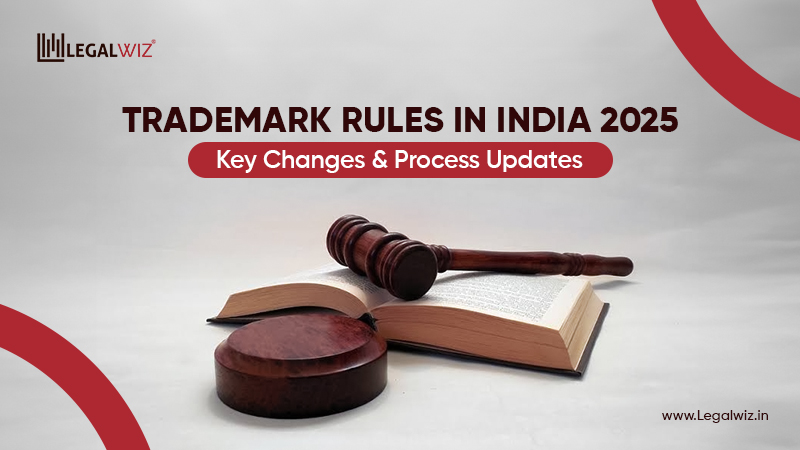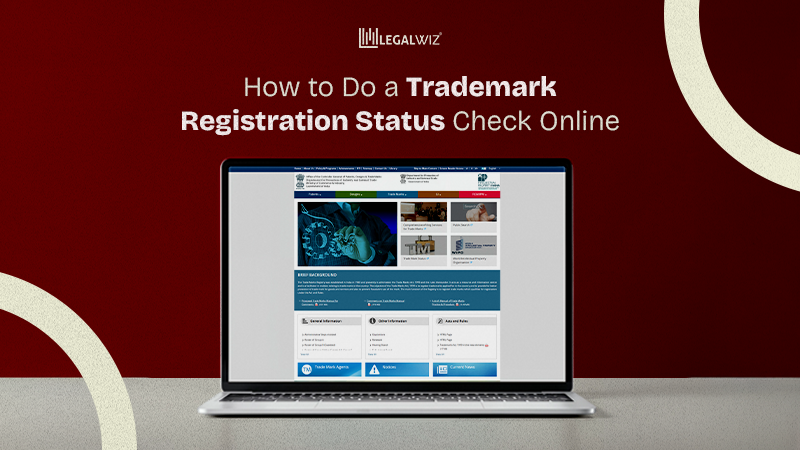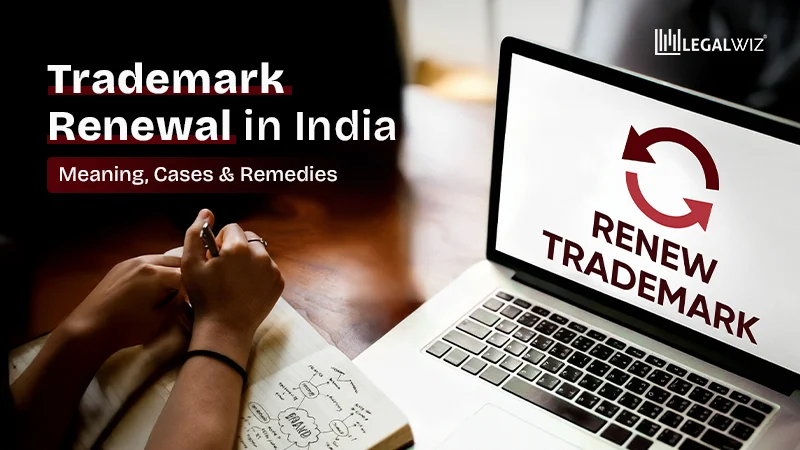Trademark Rules in India 2025: Key Changes & Process Updates
India has hit the refresh button on its trademark regulations, and let’s be honest, your plan for 2024 may already be outdated. When you thought you had trademark registration under control, along come new rules, shorter deadlines, and some surprises. It appears that the trademark system underwent an update overnight, but no one bothered to issue a notice.
Back in a day (read: last year), it wasn’t necessary to keep up with rule revisions. A great thing to have. Now? It is time to survive. A nice name and logo aren’t enough anymore. The bar has been increased, and businesses that don’t change may have to catch up or, even worse, be out of the game completely.
Let’s not forget about the discreet one: trademark renewal. It used to be only a box to tick. Now it’s a task with a strict timeline. You might lose your hard-earned privileges if you skip one reminder. Staying on top of renewals is more important than ever since the standards are stiffer and there is less wiggle space.
But don’t worry! This blog will help you go through the new trademark jungle. We’re going to explain what’s different, what it implies for your company, and how to remain ahead without going crazy.
Are you ready to jump in? Let’s figure out the trademark mess of 2025 together.
1. What is a Trademark?
A trademark is your brand’s personal autograph. It’s that little badge that tells the world, “Yep, this is mine—and mine alone.” Without it, anyone could scribble their name over your ideas and ride your reputation for free.
Now, not all trademarks are created equal. Ordinary trademarks are like your everyday signature, good for keeping casual imitators at bay. On the other hand, well-known trademarks are like celebrity signatures in the world of brands. They have power, recognition, and added protection since everyone knows who they belong to.
Read more: Understanding the Importance of Trademark Registration in India
So, whether you’re signing off on a new product or just stamping your logo on packaging, remember: your trademark isn’t just a legal formality; it’s your brand saying, “Hands off, this belongs to me!”
2. The Big 2025 Update – What Changed for Trademarking
Trademark rules just had their 2025 reset, and this time it’s not a token change. Think less red tape, more results:
- Faster timelines: Trademark applications and oppositions no longer drag on forever. The wait is shorter, which means you get clarity on your brand’s status sooner.
- Digital-first: More online filing, e-scrutiny, and fewer trips to government counters. It’s not just convenient; it saves time and cuts out the paperwork mess.
- Fee changes & category reshuffle: Some charges have changed, and categories have been rearranged, so businesses need to double-check where they fit before filing.
- Perks for startups & MSMEs: With simplified procedures, smaller businesses don’t have to wade through the same hurdles as large corporations to protect their brand identity.
Put simply, the trademark office finally swapped its typewriter for a laptop. Filing in 2025 is sharper, quicker, and friendlier for businesses that don’t have time to waste.
Well, if the government can go beyond the oldschool method, why shodn’t we? Let’s learn how to do trademark e-registration, and protect your brand identity without taking trip to the government office.
3. Filing Made Simple: How Trademarks in 2025 Got a Major Upgrade
The 2025 trademark updates are all about speed, clarity, and digital convenience. Here’s a guide for you on what has changed from the previous process:
Application Process for Trademark in India:
Good news for all of us: now in 2025, applying for a trademark won’t be all about those paperwork marathons. Instead, it will be less red tape and more “click-and-done” clarity.
What’s new in trademarking?
- Fresh forms & e-filing structure: The government has simplified application formats and reduced overlapping details. You no longer need to repeatedly upload the same set of documents at different stages.
- Mandatory digital documentation: Physical submission has been almost phased out. Scanned documents with e-signatures are now widely accepted, cutting down travel and courier hassles.
- Defined timelines for examination: Earlier, applications could sit in a queue for months without clarity. The 2025 rules fix standard timeframes for examination and response, so applicants know what to expect and when.
Why it matters:
This clarity prevents back-and-forth communication with the Registry, reduces clerical errors, and helps businesses—especially startups and MSMEs—secure their brand identity before competitors copy or misuse it.
Pro tip:
The upgraded IP India portal now has real-time status tracking and auto-updates on objections or oppositions. You can log in and see the exact stage of your application instead of waiting for vague emails or notices.
While you learn about the new updates in the application process, how about you take a look at how to register a logo trademark for your brand. This will help you to protect your legacy in a long run.
Examination & Objections in Trademark Application:
We are well aware that examination by the Registry has always been a crucial step in getting a trademark approved. For many brands, this stage is the toughest to navigate, especially when unintentional similarities with other trademarks create challenges. Under the previous process, communication gaps often caused companies to miss deadlines for filing a trademark objection reply, leading to abandonment of the entire TM application.
With the new changes, these issues are easier to avoid. Let’s see how:
What’s changed for trademark examination report?
- Structured examination reports: Examiners now issue objections in a standardised format, breaking them down into clear categories—similar trademarks, incorrect classification, missing documents, or descriptive marks.
- Defined response timelines: You now get a fixed window (usually 30 days) to respond, with reminders available through the online portal.
- Digital communication: Notices and responses are exchanged online, reducing the risk of missing important updates by post.
Why it matters:
No more scratching your head over cryptic objections. You now get a point-by-point breakdown, which makes it easier to prepare accurate responses and avoid repeat rejections.
Example:
Earlier, an objection notice might simply say “Application defective.” Now it’s more like, “Class incorrect: filed under 25 (clothing) instead of 35 (retail services). Please clarify.” Think of it as your examiner finally adding helpful margin notes instead of just big red crosses.
Want to know how to respond to a Trademark Objection? Here’s the complete lowdown: How to file a Trademark Objection
Opposition & Hearings of Trademark Application:
Even after your trademark clears examination, it isn’t fully safe yet. Third parties can raise objections if they believe your mark conflicts with theirs. This is where filing trademark opposition and hearings come into play.
What’s updated for the trademark oppotion process:
- Third-party oppositions now follow a structured, faster process, with clear deadlines for filing objections and counter-responses.
- Hearings are more predictable, with defined schedules and guidelines for submission, reducing uncertainty for applicants.
- Digital tracking allows you to monitor oppositions and hearing dates in real time, avoiding missed deadlines or surprise notices.
Why it matters:
A transparent, structured process helps you prepare your defense effectively, avoid prolonged legal battles, and address objections with clarity. This reduces the risk of your application being rejected due to procedural delays rather than substantive issues.
Example:
Think of it like a referee explaining a foul before blowing the whistle—everyone knows what’s happening, there’s less confusion, and the game is fairer for all parties involved.
Know everything about trademark opposition. Our simple, informative breakdown covers every detail you need, take a look at the full blog: Understanding Trademark Opposition
Registration & Renewal of Trademark:
The final step in securing your trademark is registration—and keeping it active through timely renewals. Thus, it’s essential to know how long your trademark is valid, as this will help you start the renewal process early. While we have all been tired of the cumbersome previous process, let’s take a look at the new changes introduced in 2025.
What’s faster in trademark renewel:
- Registration timelines have been shortened, so marks move from application to approval more quickly.
- Renewals are largely digital, eliminating repeated paperwork and long waits.
Why it matters:
With this new renewal changes, your brand stays protected without unnecessary administrative headaches, letting you focus on growth instead of forms.
Extra perks:
- Mandatory compliance checks are simplified, reducing the risk of missing deadlines.
- Startups and small businesses enjoy smoother procedures, making brand protection more accessible than ever.
Filing a trademark in 2025 is like ordering pizza with a new app: faster delivery, fewer mistakes, and extra toppings (aka protections) included. You get what you want, fully loaded and ready to go.
5. Impact of Trademark Changes on Businesses & Brand Owners
The 2025 trademark shake-up isn’t just paperwork; it’s a game-changer for businesses of all sizes.
- Startups & SMEs: Faster filings, clearer rules, and digital-first processes mean less time sweating over forms and more time building your brand. It’s like giving your trademark a jetpack.
- Bigger Companies: New compliance checks keep you on your toes, but they’re designed to be predictable and manageable. Think of it as safety rails on a high-speed rollercoaster—keeps you secure while letting you move fast.
Our insight: Your trademark’s life just got both a speed boost and a safety upgrade. Fast, protected, and stress-free—exactly how your brand deserves to roll.
| Even if you have a popular brand, if it isn’t trademarked, someone could just steal it and slap a ™ on it. And trust us—you could end up in a legal battle just to prove that it’s YOUR brand. Simply having a well-known brand won’t be enough; understanding what’s the difference between owning a brand and trademarking it can save you significant time, money, and energy. |
6. Common Mistakes to Avoid Under the 2025 Rules for Trademarking
Even with all the upgrades, brands can still stumble. Here’s what to watch out for:
- Incomplete Applications: Missing documents or wrong forms can slow you down. Double-check before hitting “submit.”
- Ignoring Digital Notices or Deadlines: Everything’s online now—miss a notice or deadline, and you’re in trouble.
- Misclassifying Goods/Services: The new system has clearer categories; pick the wrong one, and you risk delays or disputes.
Don’t let your brand get lost in the digital shuffle; follow the new rules like a GPS, and your trademark will reach its destination safely and fast. And if you think these mistakes won’t land you in a legal maze, then learn from some of the famous trademark cases for businesses. You will get the clarity of why avoiding these small mistakes can benefit your brand name in the future.
7. Tips for Smooth Trademark Filing in 2025
Getting your trademark through the system doesn’t have to be a headache. Here’s how to make it effortless:
- Use Updated Online Platforms Correctly: The new digital-first process is faster—just follow the steps carefully to avoid delays.
- Keep Evidence and Documents Ready: Proof of use, identity, and product/service details should be at your fingertips. Being prepared saves time and stress.
- Seek Expert Advice for Tricky Objections: Some objections can be technical. A trademark expert can guide you through them smoothly.
Quirky aside: Consider a trademark lawyer to be your personal guide through the jungle of rules—less stress, more GPS directing you straight to success.
Conclusion – 2025 Trademark Rules: Stay Ahead or Stay Behind
The changes to trademarks in 2025 aren’t simply paperwork; they’re a change in strategy. This is an opportunity for companies to make their brand’s legal shield stronger, make their filings easier, and keep one step ahead of the competition. Compliance is no longer just a formality; it is a way to thrive and stay safe.
Filing ahead of time and keeping an eye on things are the most crucial things. Check that all the documentation is proper and complete, maintain a track of any objections, and meet all deadlines. This might mean that small and medium-sized enterprises and startups get clearances faster and their brands are better protected. For bigger companies, it’s about minimizing risk and retaining their good brand in a market where there are a lot of competitors.
Don’t only consider your trademark registration to be a legal requirement. Think of it as a living asset that becomes more valuable and well-known as you take care of it.
With LegalWiz, renew your trademarks, protect your brand, and make 2025 the year your brand truly shines—legally, strategically, and without a doubt.
Frequently Asked Questions
What’s new in trademark rules in India for 2025?
India made a lot of major changes to trademark laws in 2025. For example, it made registration faster, added additional trademark categories, and made it easier to apply online.
How has the trademark application process changed?
The process for applying has become better. There are now fewer steps to take when applying online, and it takes a lot less time to have your trademark approved.
What’s the new classification system for trademarks?
India has added additional categories to its trademark system to make it easier for modern businesses to register their trademarks. This is especially true for new industries like digital services and artificial intelligence.
Has the trademark renewal process changed?
Sure! Renewing a trademark has never been simpler. There is easy paperwork and reminders to assist you in keeping your trademark safe by keeping on top of renewals.
How do the changes affect trademark enforcement?
These changes make it easier to deal with trademark issues. The new rules make fines for anyone who infringes on trademarks stronger, which helps safeguard trademark owners even more.

Sapna Mane
Sapna Mane is a skilled content writer at LegalWiz.in with years of cross-industry experience and a flair for turning legal, tax, and compliance chaos into clear, scroll-stopping content. She makes sense of India’s ever-changing rules—so you don’t have to Google everything twice.







